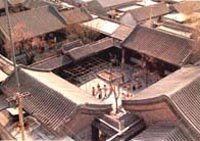Work to salvage Beijing's traditional courtyard homes seems to
have achieved some initial results, as a total of 658 of the
structures (siheyuan in Chinese) have been listed as protected
sites, thus saving them from the bulldozers.
The Beijing Cultural Relics Bureau announced yesterday that
these 658 sites, tagged with identifying blue plates over the
entrance, cannot be demolished to make way for any of the city's
massive real estate development projects.
And, for first time, the locations of these courtyards have been
posted on the Internet to assist in encouraging public supervision
of the demolition ban, said Kong Fanzhi, vice-director of the
bureau.
If they had not been tagged as protected sites, these 658
courtyards would eventually have disappeared like hundreds of other
'siheyuan' that have already been pulled down and replaced with
modern buildings or broadened streets.
"We are racing against the bulldozers because these 658
courtyards are located in areas where more than 130 reconstruction
projects are going on or scheduled to start very soon," said
Kong.
He acknowledged that there are still thousands of courtyards that
have not been listed as protected sites yet, but that most of them
will be preserved as part of historic and cultural districts like
Liulichang and Qianmen.

Kong also said his bureau has been working with
housing management and construction authorities in the protection
and repair of the 'siheyuan'. If a 'siheyuan' not under protection
faces demolition in a reconstruction project, the construction firm
should invite cultural relic experts to the site to decide whether
the 'siheyuan' should be pulled down.
Relic guardians have for many years appealed to the city leaders
for urgent measures to safeguard the traditional courtyard homes,
many of which have been destroyed in the city's urbanization drive
over the past decades.
Liu Xiaoshi, a leading architect active in the preservation of
the old Beijing, said the preservation of the 'siheyuan' was the
most urgent task in protecting the city's heritage.
He said he was glad to see that the city leaders had worked out
a string of policies to salvage them, but working out the
implementation of these policies was the most crucial thing.
Liu said: "The primary problem in protecting the 'siheyuan' is
that many people still do not have a full understanding of the
value of the traditional courtyards and regard them simply as old
derelicts that should be reconstructed.
"Actually, the best way to protect the 'siheyuan' is not
reconstruction, but rehabilitation; that is to say, repairing the
broken parts and introducing modern water and electricity systems
in order to improve living conditions in them."
(China Daily December 4, 2003)